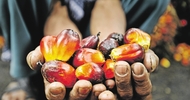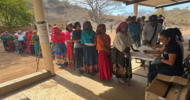Agricultural Productivity as Performance: A Tale of Two Mozambican Corridors
ByIn what is now remembered as the Great Leap Forward, 15 to 55 million people died of starvation in Mao Zedong’s China. Decreeing increased efforts to multiply grain yields, Chairman Mao unleashed panic in rural China, and local officials, fearful of the national government, competed to fulfil (or over-fulfil) quotas based on Mao’s exaggerated claims, collecting “surpluses” that in fact did not exist and leaving farmers to starve as a result.
The Great Leap Forward took place between 1958 and 1962. Such schemes ostensibly aimed at improving the human condition and which end up in epic failure, as observed by James C. Scott, have reoccurred throughout history.
Other examples may not have led to a widespread loss of life as happened in mid-twentieth century China, but they have certainly produced hybrid and rather unpredictable outcomes. An agricultural campaign with similar objectives as the Great Leap Forward was adopted by the Mozambican government for the year 2018/19.
It rallied smallholder farmers to increase production and productivity under the motto, “Mozambique Increasing Production and Productivity Towards Zero Hunger”. In the end, Mozambican farmers were unable to significantly increase production.
They had faced a number of challenges: limited access to credit, fertilizer, farm inputs, and feeder roads, and thus to markets. Which is to say, without easy access to markets, any surplus the farmers had produced was wasted before it even got to market.
What is more important to consider is the fact that this failure to increase the productivity of rural farmers in Mozambique had occurred at the same time as the government had put in place measures to commercialise agriculture along two important transport corridors located in its central and northern regions, that is, the Beira and Nacala agricultural corridors. The Mozambican government had been mobilizing international capital over a decade or so, in order to build and renovate transport infrastructure with the aim of commercialising agriculture along the corridors.
Despite attracting some capital and infusion of technology, capital flows and technological transfers were generally unpredictable as they largely depended on the intervention of multiple actors and the dynamics of the global economy and global commodity prices. Adding to the lack of the much-needed infrastructure was the absence of Mozambican capital, as the banking system in Mozambique was unwilling to take the risks that come with financing agriculture. Investments in agriculture normally take 5-10 years to show visible returns, and Mozambican investors cannot afford to wait that long.
Additional challenges to the implementation of the Beira and Nacala agricultural corridors were related to national and local politics. On the one hand, the armed confrontation between government forces and the armed branch of the major political party in the opposition, Renamo, which affected parts of Sofala and Nampula provinces between 2013 and 2016, had led to a reduction of investments, disrupting the flows of existing businesses. Also, agricultural corridors, in particular the Nacala corridor, tend to generate anxiety over land, leading to continuous debates and campaigns over “land grabbing” and land titling. As a result, both the Beira and Nacala agricultural corridors faced significant challenges in their implementation.
Investments in agriculture normally take 5-10 years to show visible returns, and Mozambican investors cannot afford to wait that long.
The vision of their blueprints, that is, of interlinked agricultural activities – that would have stretched from the cities of Beira and Nacala on the Indian Ocean up to Mozambique’s land-locked neighbours, Zimbabwe, Zambia and Malawi – is yet to materialize. Despite the fact that such a grand vision is yet to materialize – if at all it will – this piece highlights its material consequences on the ground.
As a recently published special issue of the Journal of Eastern African Studies on growth corridors has shown, a careful examination of the planning, implementation and effects of agricultural corridors suggests that they often generate anxiety over land, and potential environmental impacts, and reconfigure power dynamics between international capital, local elites, bureaucrats and smallholder farmers – whether or not their official objectives are achieved.
By focusing on the practices of international investors, national elites, local bureaucrats and project beneficiaries, this research has suggested that, in order to attract capital, selected regions for development projects must dramatize their potential as places for investment, carefully selecting project locations and participants who will make compromises so as to conceal failure, virtually guaranteeing that the programme will be declared a success when the time comes for evaluation. These performances of success require the participation of a constellation of actors in order to be effective.
Along the Beira and Nacala agricultural corridors of Mozambique, there has been a widespread trend where international funders and investors, national elites, local bureaucrats and smallholder farmers collude in performing agricultural success, not only to attract the much-needed international capital, but in ways that bring the largely non-existent corridors to life. Agricultural corridors in Mozambique, in this sense, emerge on those occasions when international funders and investors, national elites, local bureaucrats and smallholder farmers overstate the success of agricultural projects – much like Chinese local officials did in the early 1960s. Below are two examples worth considering.
The tomato processing plant that never was
The administrative post of Tica in Nhamatanda District – along the Beira agricultural corridor – is famous for its abundant production of tomatoes. They are often left to rot when farmers are not able to sell all their produce.
In the local media, talk of building a tomato processing plant in Tica can be traced back to 2009, when a local entrepreneur reportedly received about US$33,000 from the Nhamatanda District Development Fund to build a tomato processing plant in order to capitalize on the district’s agricultural potential. In some of the media accounts, the processing plant was presented as if it already existed, running and fulfilling its promise to absorb the horticultural produce of farmers along the Beira agricultural corridor.
In 2013, a daily newspaper Notícias, published a news piece with the title, Processing plant created in Nhamatanda. The content of the news was based on an interview with the then district administrator of Nhamatanda, who said that a building plot had been located for the construction of the processing plant, and that a public tender for constructors had been announced and bids were awaited. He stated that the building would be completed by December 2013, and that equipment would be installed by February 2014.
There has been a widespread trend where international funders and investors, national elites, local bureaucrats and smallholder farmers collude in performing agricultural success.
In April 2015, another headline by the Voice of America read, Tomato processing plant changes the lives of producers in Tica. This story was based on two women who had been making a living for over 12 years selling tomatoes at a small agricultural market. This time the district administrator was announcing that the building was going to be completed by May 2015. In February 2018, another headline announced, This year Nhamatanda is going to process tomato, in an article where a district administrator was boasting of the 200,000-tonnes capacity of the future processing plant, advising local farmers to get ready to “produce a lot” since there was going to be a company to buy their produce.
When I visited the factory in March 2018, the building was not equipped. In a follow-up visit three months later, the main building of the processing plant was closed; a small agricultural inputs shop was operating from the security booth. The main building had caught fire at some point, and was closed pending repairs. The situation on the ground was in stark contrast to what district officials had been telling visiting researchers and journalists.
Ideas such as the introduction of financial services or the provision of technical assistance and tillage services are attractive, not only to farmers, but also to international donors and investors, but at the time the success of the tomato processing plant in Tica was being widely touted in the media, most of these plans were yet to materialize. The fire did indeed put an abrupt end to the brief lifespan of the plant, but the expectation of agricultural commercialisation that the plant had generated in the region long before it began operating exemplified the extent to which local officials were willing to create a narrative of success around a project in anticipation of, or as a means of attracting the much needed but seriously lacking investment capital.
A very important agribusiness fair
On 7 and 8 July 2018, an agribusiness fair took place at the municipal soccer field of Ribáuè in Nampula province along the Nacala agricultural corridor. The fair was entitled Nakosso Agribusiness Fair: Facilitating Access to Markets, and was the first of a series of five fairs to be organized in northern Mozambique by a private company working in partnership with the Swiss Agency for Development and Cooperation. The fair was an important event in the calendar. The provincial governor opened it in a ceremony that was also attended by the Ministers of Agriculture and Rural Development, and by the Minister of Industry and Commerce.
The fair had stands showing various products by local farmers’ associations, whose work is often done with the support of district extension officers, and through a number of NGO-supported projects. As the visiting dignitaries went from one exhibition stand to another, the interaction with exhibitors was punctuated by questions, compliments and suggestions for improvement. The opening ceremony ended with the provincial governor’s speech, where he congratulated the exhibitors and encouraged them to continue the good work.
The events that took place during the fair, including the governor’s speech, were disseminated across the district through local radio station news programmes by the end of the day and the following morning they featured in the provincial news broadcast – a local feat.
The processing plant was presented as if it already existed, running and fulfilling its promise to absorb the horticultural produce of farmers along the Beira agricultural corridor.
In many ways, the fair represented the desired agricultural life in the district, showcasing products and opportunities for smallholder, medium and large-scale farmers in the production and commercialization processes – financial institutions, input providers and dealers, extension officers, successful smallholder farmers and large commercial farms were all brought together at the fair in a performance of agricultural success.
While district statistics point to the growth in local production and productivity in the past three years, the fair is especially effective as a field to demonstrate agricultural productivity all throughout the corridor, giving materiality to the corridor as a result, and enlisting a network of actors in the project of corridor making. In other words, the example of the fair illustrates how such events can provide occasions for the demonstration of success, and the creation of an ideal vision for the agricultural corridor. In Mozambique, the significance of agricultural fairs is perhaps best exemplified by the fact that they form a distinctive feature in the agenda of visiting high-level dignitaries, from the president of the republic, to provincial governors and ministers.
Despite the fact that on some occasions visiting dignitaries have questioned the blatant exhibition of produce brought in from other areas – in ways similar to the deception adopted by local officials in 1960s China – the fair is presented as a sample of agricultural developments already taking place in other areas covered by the corridor, especially given the efforts local officials put into achieving some kind of geographical representation of exhibitors. Finally, the fair also provides an opportunity for a pedagogy, through the celebration of cases of success that should be seen as models to be followed by other actors, in particular smallholder farmers.
In Mozambique, the significance of agricultural fairs is perhaps best exemplified by the fact that they form a distinctive feature in the agenda of visiting high-level dignitaries.
The idea of the corridor, whether the corridor existed or not, was in Mozambique, producing material effects on the ground.
The lesson
Without actual investments and infrastructure, blueprints, visions and policies for agricultural commercialisation in Mozambique come to be, or are given visibility, only when specific agricultural projects within the geographical location of the corridor are presented as successful.
At these events, complex entanglements emerge, exemplifying the everyday work of international funders and investors, national elites, local bureaucrats, and smallholder farmers, as they all perform project success on different occasions. Meanwhile, agricultural commercialisation, within the identified corridor region, remains low.
The lesson from these examples is that whether or not they achieve their official objectives – often to increase productivity and lift people out of poverty – development plans, visions and blueprints have material consequences.
Dr. Euclides Gonçalves a social anthropologist and director at Kaleidoscopio – Research in Public Policy and Culture. His research focusses on governance, bureaucratic processes and political rituals.
Support The Elephant.
The Elephant is helping to build a truly public platform, while producing consistent, quality investigations, opinions and analysis. The Elephant cannot survive and grow without your participation. Now, more than ever, it is vital for The Elephant to reach as many people as possible.
Your support helps protect The Elephant's independence and it means we can continue keeping the democratic space free, open and robust. Every contribution, however big or small, is so valuable for our collective future.














